Menu
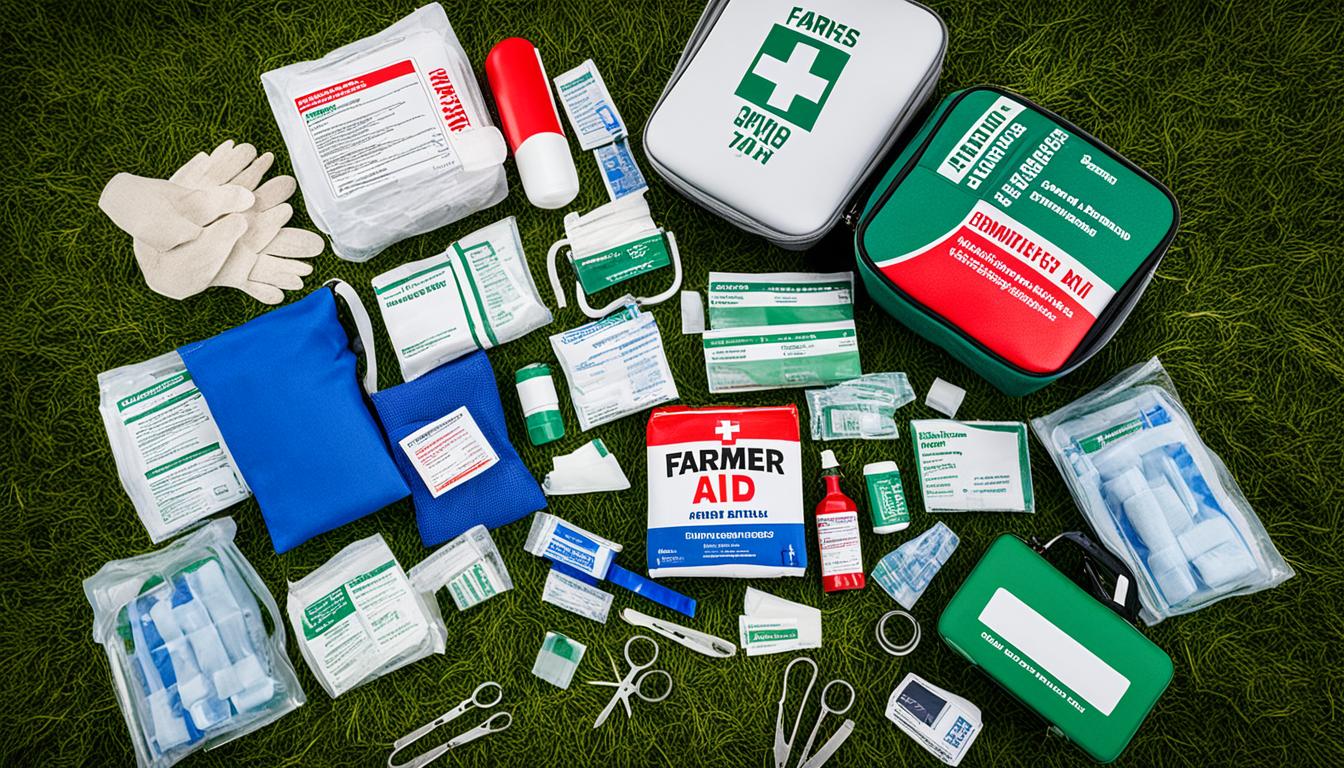
Have you thought about the importance of first aid on farms? Farming has many dangers, but being ready can save lives. Accidents with machinery, bites from dangerous animals, and severe cuts are common. So, having the right first aid kits and trained help is vital.
Every Farm Manager needs to make sure there are plenty of First Aid kits around. These kits must be ready for anything, like snake or spider bites, sprains, cuts, and more. Telling staff how to do first aid for farming can stop bad injuries or death, making work safer.
Managers should get First Aid kits from trusted places like St John Ambulance and the Australian Red Cross. They must check the kits often and refill them quickly. Making a strong emergency plan and using good ways to talk, like radios and phones, makes the farm safer too.
Farms have lots of risks, so first aid is crucial for safety. With proper first aid, we can lower the risk of injuries being severe or fatal. It’s vital to have first aid ready and people trained to use it in an emergency.
Managers must make sure everyone on the farm can get to a First Aid kit quickly. These kits should have items for most emergencies, like snake bites and cuts.
Training lots of people in First Aid makes it more likely we can save lives. Being prepared lets us act fast when we have little time.”
Managers should also have a detailed plan for emergencies. This should include how to contact help and what to do in different crises. Practice runs help ensure everyone knows what to do in an emergency.
Good farm emergency response means having easy ways to call for help. Include clear directions to the farm for ambulance, police, or fire. Remember, calling 000 can get you the help you need fast.
Keeping first aid kits up-to-date and training all staff are key to farm safety. Following emergency plans closely can avoid serious harm from farm accidents.
Working on a farm comes with many risks. It’s crucial to be ready for common injuries and emergencies. This includes preparing for potential dangers and ensuring you know how to handle farm first aid. By knowing what accidents can happen, medical care in rural areas can act quickly and be more effective.
Venomous snakes and spiders are often found on farms. Rattlesnakes bites and bites from spiders like black widows can be very dangerous. They can cause symptoms such as muscle twitches and vomiting. It’s important for farmers to be alert and learn how to respond quickly to these hazards to avoid further problems.
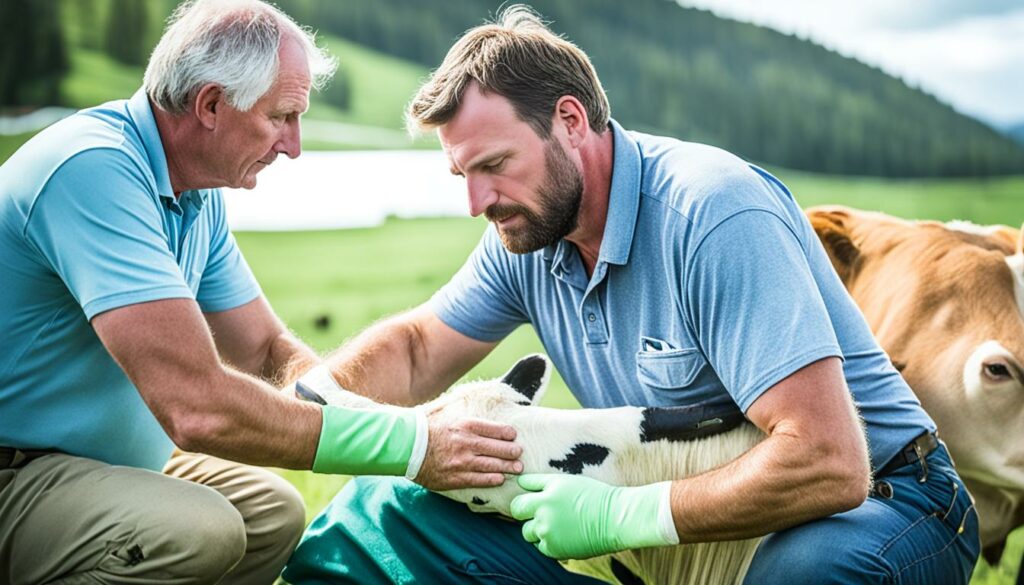
Sprains, cuts, and burns happen a lot due to farm work and large machines. It’s vital to take care of these promptly. Keeping a first aid kit nearby, and knowing how to use it, can help. This ensures that help is available right on the farm.
More serious injuries on farms can involve broken bones or crush injuries. These are very worrying because some might need amputation. They often happen because of machine accidents or with handling animals. Having the right first aid training is key. It helps in managing these emergencies quickly and well, reducing the long-term effects.
Building a top-notch first aid kit is key for swift farm emergency responses. It lets workers quickly handle small injuries and prepare for bigger accidents. It’s important to include certain items and keep the kit up-to-date.
Every first aid kit should have vital tools for treating common farming injuries. These essentials include:
On top of the basics, having farm-specific gear is crucial. This includes both large kits for farm buildings and homes, and smaller kits for vehicles and tools. These must have items for different situations:
Keeping your first aid kit ready means regularly checking and updating it. An annual inspection ensures you fix or replace out-of-date items. This includes ointments, ice packs, and batteries for flashlights. It’s also vital to personalise kits for different farm spots. Restock them after any use and refresh expired items.
| Kit Type | Essential Items | Specialised Equipment |
|---|---|---|
| Main Farm Kit | Sterile dressings, bandages, antiseptic wash | Amputation tools, fracture kits, emergency blanket |
| Vehicle Kit | Adhesive tape, first aid manual, basic bandages | PE exposure gear, machinery injury tools |
| Farm Equipment Kit | Scissors, tweezers, gloves | Special dressing supplies, pesticide antidotes |
Getting trained in first aid and CPR by reputable groups like the American Red Cross is also important. This, alongside a well-stocked kit, makes for a strong, full farm emergency response.
Agricultural first aid training can save lives. Farm work has many dangers, so first aid must be special. Workers could face snake or spider bites, cuts, burns, and even being shocked. So, knowing first aid is very important for them.
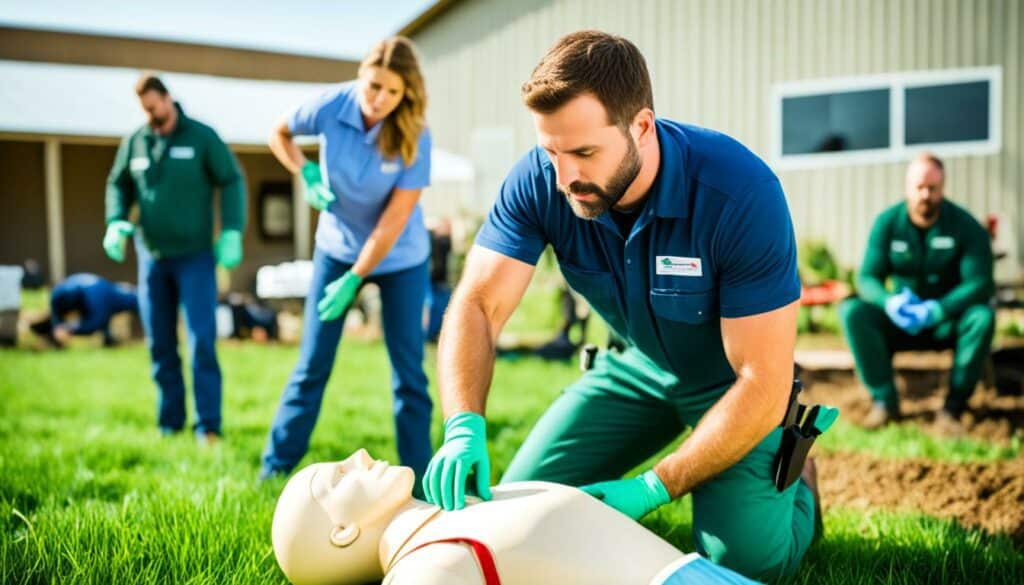
Having first aid kits on farms is vital. They help get medical help quicker, saving lives. You can get these kits from places like St John Ambulance and the Australian Red Cross. They are made for farm needs. You can also find them at chemists, hardware shops, and places that sell farm supplies.
Farm safety means having regular first aid lessons. Groups like St John Ambulance and the Australian Red Cross, along with local colleges, offer these. They teach about dealing with different issues, like being poisoned or caught in a fire.
Good communication is also key for farm safety. Things like radios, phones, and Personal EPIRBS help quickly get help to those hurt, especially far from help. It’s also smart to have clear plans for emergencies. These should include what to do if a machine hurts someone, or if there’s a big storm.
These safety courses have been taught for more than 15 years now. They follow rules from OSHA and ANSI, which keep workers safe. Classes last around 2 to 2.5 hours, and you have to pass a test. You can learn in many ways, like online, using kits at home, or training to be a teacher. This way, everyone can find a way to learn that works for them.
To end, making first aid training part of farm safety not only follows the law but also makes farms safer. By giving the right training and tools, we make sure farms are places where people are well looked after. This makes work better for everyone.
An effective farm emergency response plan is key for handling risks and keeping everyone safe. It involves quick actions and plans for long-term farm health.
Such a plan should have many parts. These include up-to-date emergency contacts, care for animals every day, how to manage workers, how to get needed resources, and ways to keep selling products even in emergencies.
Farmers should know how to deal with dangers like toxic gas and have the right gear to protect themselves and their livestock.
Good communication is a must for any farm emergency response to work well. Clear lines of communication make sure everyone knows what to do. This includes talking with outside help when needed.
Farms can face lots of different kinds of troubles. These can be natural, like floods and tornadoes, or accidents with machines or fires. For each problem, you need the right plans ready to go.
An example is checking gas levels near manure and letting only trained people in. Farms in places like Minnesota should be ready for bad weather too, with plans for tornadoes and heavy snowfall. Practising these plans with drills will make them work better when you really need them.
Being ready for emergencies is crucial for running a farm. With a detailed farm emergency response plan, farmers can lower their risks and keep their work going safely.
Looking after livestock injuries demands special knowledge. Farms have many dangers, from small incidents to life-threatening events like being trampled. Farm first aid preparedness is key to handling these situations well.
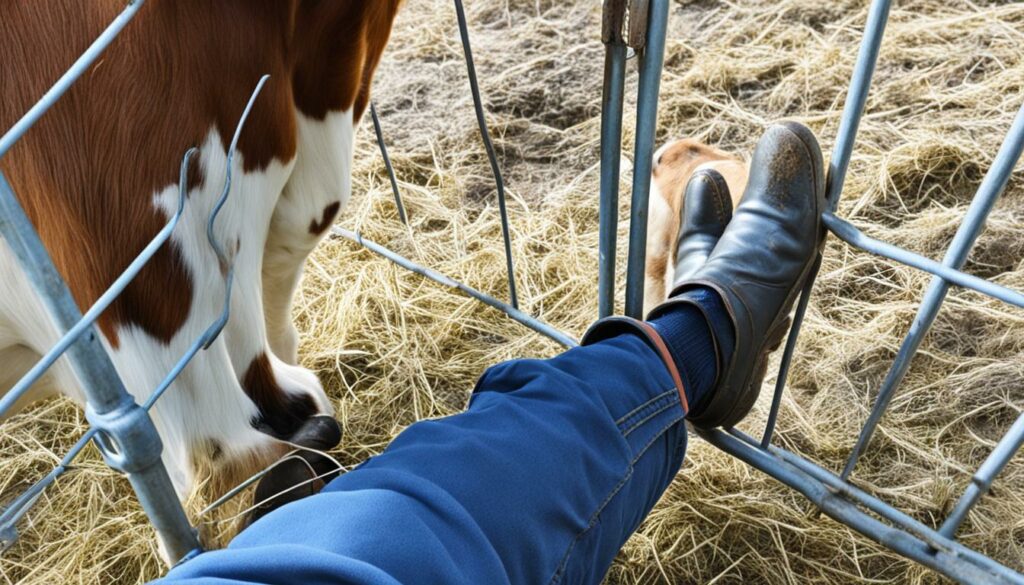
Keeping a list of emergency contacts is a must. This is critical for making fast decisions, especially when the farm owner isn’t around. It’s not just about quick reactions but also making sure the animals are cared for daily. This care includes feeding the right amount at the right time, sorting out air flow, dealing with dead animals, and looking after specific animals.
Farm safety procedures say that you need to plan how to manage work when things go wrong. You should know how long different tasks will take and have trained people ready for any job. Also, You must keep the farm clean and safe all the time. During emergencies, having the right supplies, like medicine, first aid kits, and feed, is crucial. You also need to give clear orders about how to use important equipment.
It’s best to avoid farm injuries and deaths by working safely. Wearing loose clothes is a big cause of accidents. I advise wearing clothes that fit well, keeping sleeves fastened, shirts inside trousers, and not wearing ties or loose jewellery.
Training people on the farm to save lives is very important. Everyone should know how to do first aid and CPR. Good organizations, like St John Ambulance or the Australian Red Cross, should give this training.
Good communication is key during farm emergencies. This is especially true in remote areas. It’s important to have reliable ways to get in touch with others quickly. Tools like two-way radios, mobile phones, and Personal EPIRBs help a lot in seeking immediate help.
Many serious injuries highlight the need for prompt communication. For instance, amputations from machinery underscore the importance of quick help. Farm workers need tools that let them get in touch with emergency services fast.
Farm First Aid kits should always be within reach. They should be ready to treat injuries commonly seen on farms. You can get these kits from places like St John Ambulance, the Australian Red Cross, and local pharmacies. It’s crucial to have a well-stocked kit for emergencies.
Many groups offer First Aid training tailored to farm workers. The Australian Red Cross, St John Ambulance, TAFE colleges, and Rural Fire Services all provide such training. This training is vital for getting workers ready to address emergencies.
Having an Emergency Plan is very important. It should cover various situations like fires, floods, and accidents. A good plan, along with clear communication, ensures everyone knows what to do in an emergency.
Effective farm communication is essential for those working alone or in far-off places. Making sure all communication tools work and workers know how to use them boosts safety during emergencies.
It’s also smart to have an Emergency Contact card near phones and radios. This makes it quick to find important numbers and information. It helps improve communication during emergencies.
To learn more about getting ready for emergencies on the farm, check out Farm Emergency Preparedness.
Starting with the idea that stopping an accident early is better than fixing things later is key. Using solid farm safety procedures helps avoid dangers and keeps the farm a safe place to work. Being well-prepared in farm first aid is vital as it can lower injury risks and save lives during accidents.
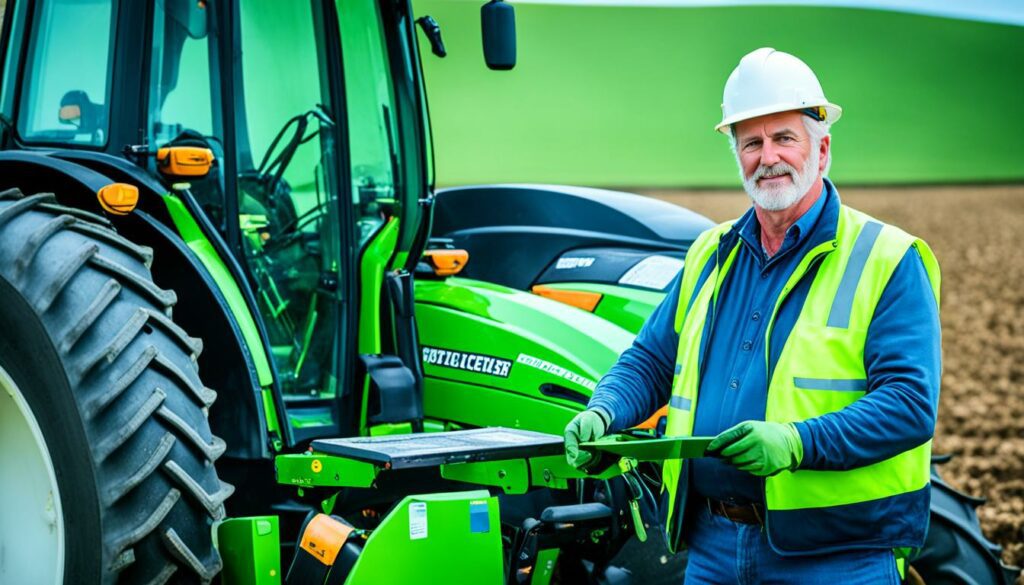
Wearing the right Personal Protective Equipment (PPE) is crucial for everyone’s safety. This includes items like helmets, gloves, and safety glasses. PPE is the first defence against many farm dangers.
Taking regular care of farming tools stops accidents from happening. Farm machines with Power Take-Off (PTO) are especially risky without proper care. Don’t miss regular checks and fixing things promptly to make sure all tools and machines are safe to use.
Safety at work goes beyond using PPE and looking after equipment. It means using the right safety rules, like clear communication and routine safety practices. Always let someone know if you’re getting off a machine and never try to fix it while it runs.
| Safety Measure | Description | Importance |
|---|---|---|
| Using PPE | Helmets, gloves, and eye protection | First line of defence against hazards |
| Regular Equipment Maintenance | Inspection and repair of machinery | Prevents accidents and ensures functionality |
| Safe Work Practices | Alerting others, safe dismounting, etc. | Minimises risk through proper procedures |
Farm managers are key in making sure farms are ready for emergencies. They do this by getting enough first aid kits, training staff, and making detailed emergency plans. This means there are enough first aid supplies around to reduce injury risks.
It’s important for farms to have the right first aid kits. These kits should help with various accidents like snake bites, and broken bones. It’s also key to teach many people first aid so they can help in an emergency.
Managers also need to create a good emergency response plan. This plan should include how to talk in emergencies, using radios and phones. It has to give clear steps for what to do in fires or accidents with machines. They also need to put Emergency Contact Cards near phones. This helps with fast help from emergency services.
Testing out emergency situations with the team is vital. These practices make sure everyone knows what to do. With good preparation, farms can handle real emergencies well.
| Essential Farm First Aid Items | Specialised Equipment |
|---|---|
| Bandages | Snake and Spider Bite Kits |
| Antiseptics | Burn Dressings |
| Scissors | CPR Masks |
| Gloves | Splints |
To sum up, farm managers play a big part in keeping farms safe and ready for emergencies. Their efforts with first aid supplies, training, and plans make farms safer places to work and live.
Ensuring you are ready for farm first aid is key to dealing with the dangers on a farm. It’s vital to have a complete first aid kit. This kit should include antiseptics, bandages, splints, and burn ointment.

Moreover, everyone on the farm should have agricultural first aid training. This helps workers act fast and well when an injury happens. Doing emergency drills from time to time is a great idea. It lets the team practice in a safe setting and boosts farm safety.
It’s also important to have plans for different emergencies. For example, a plan for when severe weather strikes. Make sure that everyone can leave quickly and safely if needed. It’s important to be ready for 72 hours, with food and supplies for three days. Don’t forget about the animals. Have safe places for them if an emergency happens.
Here is a quick checklist for being ready in farm first aid situations:
| Component | Description |
|---|---|
| First Aid Kit | Stocked with all essentials including antiseptics, bandages, and burn ointment |
| Training | Regular first aid training to ensure effective response |
| Emergency Drills | Periodic drills to simulate various emergency scenarios |
| 72-Hour Preparedness | Ensure three days’ worth of food and essential supplies |
| Evacuation Protocols | Clear guidelines for evacuating people and animals safely |
By following these steps, you can make your farm much safer and ready for any issue. First aid preparedness is about more than just having what you need. It’s about creating a culture of safety and watchfulness.
Looking at real-life cases helps us learn about dealing with fires, accidents, and natural disasters on farms. These stories show us what works to handle emergencies well. They teach us to be ready with first aid and how to get quick medical help in the countryside.
Farm fires are dangerous because there are usually hay and other flammable things around. Take the example of a barn fire at a livestock farm. Workers acted fast with first aid and tools to fight the fire. They stopped it from getting worse. This case shows the need for a clear emergency plan and training for all on the farm.
Accidents with farm machines can be severe, causing bad injuries. In a tractor rollover case, quick first aid and local medical care made a big difference. They helped the worker survive. This event highlights how vital it is to have first aid ready and to work well with local medics.
Events like floods and wildfires are tough on rural regions. The 2019 Nebraska flood shows why good planning is key. The farm’s readiness and teamwork lessened harm to animals and buildings. It proves that being prepared for first aid helps handle medical issues during such crises.
Here’s a table with key cases and how good responses made a big difference:
| Incident Type | Key Response Measures | Outcome |
|---|---|---|
| Fire Incident |
| Minimised damage and loss |
| Machinery Accident |
| Prevention of fatal injuries |
| Natural Disaster (Flood) |
| Mitigated impact on livestock and infrastructure |
Good rural medical care is very important, especially for farm first aid preparedness. Rural areas have unique challenges like being far from cities, having little medical help, and not enough trained people. This makes it crucial for them to have good first aid skills and easy access to doctors and hospitals.
Studies show that 30% of people who help first at emergencies develop mental health issues. Working in rural places can make these problems worse. These areas often depend on volunteers for emergency help, which means they may not have insurance. This makes getting medical help when needed harder and more expensive.

The COVID-19 pandemic made rural medical care even more vital. In Louisiana, even emergency help in rural areas was given vaccines, showing the value of working together. Regular training and having the right tools for first aid on farms are key. They help people react quickly and well in an emergency.
To support those who help first, it’s important to educate them well and set up easy ways to talk. Working with schools, churches, and people who used to be in the medical field can also help. They can fill in for the lack of staff in rural healthcare.
Efforts to better rural medical care include many training programmes. For example, the Rural Domestic Preparedness Consortium and the US Department of Health both provide some. These courses range from how to understand different cultures in emergencies to handling crises effectively as a first responder.
Farm first aid preparedness aims to keep first responders safe too. For this, they should have the right gear and work together closely. Also, it’s vital they always have updated contact details and know how to talk to each other in different ways during an emergency.
Every rural area should plan for all kinds of emergencies. This means not just thinking about medical problems but also about disasters and how to keep everyone safe. It’s important to work with other groups to make strong plans for handling these situations.
| Challenges | Mitigation Strategies |
|---|---|
| Limited funding and resources | Develop partnerships with organisations and employ volunteers |
| Longer response times | Conduct regular drills and familiarise with emergency management systems |
| Mental health risks | Offer training, clear information, and support channels |
| Staffing gaps | Utilise retired first responders and community partnerships |
To ensure rural medical care is good and people are ready for emergencies, it takes a team effort. By working together to face these issues, rural areas can be much better prepared for emergencies. They can also improve the health of their communities.
Farm first aid preparedness is key for safety in agriculture. It’s important in facing farming’s unique challenges. Regular training drills help keep our skills sharp for emergencies.
On farms, accidents can be found late, sometimes after a long time. People may have to move far for medical help, delaying care. That’s why regular first aid training in farming is essential. It ensures that all team members can act fast and provide the right help.
With proper training, one learns how to rescue and give first aid quickly. For example, checking how someone’s breathing and reacting fast is vital. This helps us know what to do next. Knowing to stop bleeding by pressing and raising the wound saves lives. Using tourniquets late but when needed is also taught.
Training also shows why calling for emergency help is crucial. It gets professionals to the scene fast for better care. It also teaches how to save body parts that might be reattached later. Knowing who to call and giving clear directions to first responders can be a lifesaver.
In the world, drills have proved to make a big difference. Studies from disaster zones and earthquake workshops show this. These findings support the use of drills in farm safety. They help save lives and react well in a crisis.
Farm first aid is very important for those working on farms. It keeps everyone safe. Farms need several first aid kits placed where they can be quickly reached. These kits should have both general items and others for special needs.
Accidents on farms can happen at any time, even at night or in bad weather. Every first aid kit should have flares, flashlights, and blankets. Kits need to be checked often, with old items replaced. Having things like clean dressings, bandages, and antiseptic helps in many emergencies.
It’s a good idea to have special kits for specific injuries or accidents on the farm. Farm workers should learn first aid and CPR every year to help with emergencies. It’s very important to regularly check the tools and machines on the farm to make sure they’re safe to use. Proper safety gear for everyone and knowing what to do in an emergency are key to preventing accidents.
Making safety a top priority on the farm is crucial. It not only keeps workers safe but also helps the farm keep going. A plan to act fast in emergencies and knowing how to handle chemicals can really help. Farm workers should also learn about the dangers of working too hard in the heat. These steps prepare the farm to respond well in any crisis, making the work environment safer for everyone.
First aid on farms is vital because of the dangers in agriculture. It can save lives and lessen harm. This shows why the right supplies and people who know how to use them are key.
A good first aid kit for farms has basics for cuts, sprains, and burns. It also includes things for farm-specific injuries. It’s important to check and refill these kits often.
St John Ambulance and the Australian Red Cross offer first aid courses just for farms. Ongoing training and drills make this knowledge stick and help in real emergencies.
Farms see injuries from animals, falls, sharp objects, and machinery. Knowing about these risks helps plan for medical needs and training.
A good plan has steps for communication and how to handle different emergencies. Practicing these plans makes sure everyone knows what to do if something goes wrong.
Livestock can hurt with kicks, bites, or by stepping on you. Knowing how to treat these injuries and having the right gear is crucial.
In emergencies, good communication is everything, especially in the middle of nowhere. Phones, radios, and beacons help people get aid quickly, which can save lives.
Wear PPE, keep machines in shape, and make the workplace safe. This cuts down on accidents and makes the farm a safer place to work.
Farm managers lead in getting the right first aid gear, training the team, and making a solid emergency plan. They help keep the farm safe and ready for the worst.
Getting medical help fast is key, especially in the countryside. Knowing how to get to a hospital quickly is life-saving.
Drills help keep emergency skills sharp. They make sure everyone knows their part in staying safe and dealing with accidents.